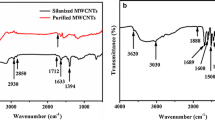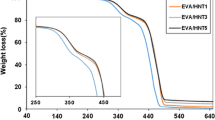Abstract
High modulus and thermal stability of polyimide (PI)/reactive halloysite nanotubes (HNTs) nanocomposites were prepared by in situ polymerization. The pristine HNTs were firstly handled with the tetraethoxysilane (TEOS) and secondly grafted with the silane agent. The fourier transform infrared spectroscopy (FTIR) approved that TEOS was beneficial for the silane agent to modify the HNTs. Scanning electron microscopy (SEM) showed the differences of the morphology between the reactive HNTs and pristine HNTs. PI/reactive HNTs nanocomposites exhibited lower moisture absorption than pure polyimide. The reactive HNTs reduced the transmittance of the nanocomposites. Significant improvements in the thermal stability and glass transition temperature (Tg) of PI/reactive HNTs nanocomposites were achieved by addition of only a small amount of reactive HNTs. It was noteworthy that both the tensile strength and Young’ modulus of PI/reactive HNTs nanocomposites were significantly enhanced. A 62.8 % increase in tensile strength and a 63.7 % increase in Young’ modulus of the nanocomposites with 3 wt.% of the reactive HNTs were achieved. Finally, the preparation mechanism to obtain PI/reactive HNTs nanocomposites was proposed.










Similar content being viewed by others
References
Tang Y, Deng S, Ye L, Yang C, Yuan Q, Zhang J, Zhao C (2011) Effects of unfolded and intercalated halloysites on mechanical properties of halloysite–epoxy nanocomposites. Compos A Appl Sci Manuf 42(4):345–354
Lin TF, Zhu LX, Chen T, Guo BC (2013) Optimization of mechanical performance of compatibilized polypropylene/poly(ethylene terephthalate) blends via selective dispersion of halloysite nanotubes in the blend. J Appl Polym Sci 129(1):47–56
Qiu K, Netravali AN (2013) Halloysite nanotube reinforced biodegradable nanocomposites using noncrosslinked and malonic acid crosslinked polyvinyl alcohol. Polym Compos 34(5):799–809
Fréchet JMJ (2005) Functional polymers: from plastic electronics to polymer-assisted therapeutics. Prog Polym Sci 30(8–9):844–857
Podsiadlo P, Kaushik AK, Arruda EM, Waas AM, Shim BS, Xu J, Nandivada H, Pumplin BG, Lahann J, Ramamoorthy A, Kotov NA (2007) Ultrastrong and stiff layered polymer nanocomposites. Science 318(5847):80–83
Landfester K (2009) Miniemulsion polymerization and the structure of polymer and hybrid nanoparticles. Angew Chem Int Ed 48(25):4488–4507
Sinha Ray S, Okamoto M (2003) Polymer/layered silicate nanocomposites: a review from preparation to processing. Prog Polym Sci 28(11):1539–1641
Zhao H, Shipp DA (2003) Preparation of poly (styrene-block-butyl acrylate) block copolymer- silicate nanocomposites. Chem Mater 15(14):2693–2695
Janek M, Emmerich K, Heissler S, Nüesch R (2007) Thermally induced grafting reactions of ethylene glycol and glycerol intercalates of kaolinite. Chem Mater 19(4):684–693
Letaïef S, Aranda P, Fernández-Saavedra R, Margeson JCJ, Detellier C, Ruiz-Hitzky E (2008) Poly (3, 4-ethylenedioxythiophene)–clay nanocomposites. J Mater Chem 18(19):2227–2233
Kaushik AK, Podsiadlo P, Qin M, Shaw CM, Waas AM, Kotov NA, Arruda EM (2009) The role of nanoparticle layer separation in the finite deformation response of layered polyurethane-clay nanocomposites. Macromolecules 42(17):6588–6595
Tunc S, Duman O (2010) Preparation and characterization of biodegradable methyl cellulose/montmorillonite nanocomposite films. Appl Clay Sci 48(3):414–424
Mirabedini S, Behzadnasab M, Kabiri K (2012) Effect of various combinations of zirconia and organoclay nanoparticles on mechanical and thermal properties of an epoxy nanocomposite coating. Compos A Appl Sci Manuf 43(11):2095–2106
Wheeler PA, Wang J, Mathias LJ (2006) Poly (methyl methacrylate)/laponite nanocomposites: exploring covalent and ionic clay modifications. Chem Mater 18(17):3937–3945
Kuan HC, Chuang WP, Ma CCM, Chiang CL, Wu HL (2005) Synthesis and characterization of a clay/waterborne polyurethane nanocomposite. J Mater Sci 40(1):179–185
Lan T, Kaviratna PD, Pinnavaia TJ (1994) On the nature of polyimide-clay hybrid composites. Chem Mater 6(5):573–575
Tyan HL, Liu YC, Wei KH (1999) Thermally and mechanically enhanced clay/polyimide nanocomposite via reactive organoclay. Chem Mater 11(7):1942–1947
Huang T, Lu R, Su C, Wang H, Guo Z, Liu P, Huang Z, Chen H, Li T (2012) Chemically modified graphene/polyimide composite films based on utilization of covalent bonding and oriented distribution. ACS Appl Mater Interfaces 4(5):2699–2708
Kumar M, Singh K, Dhawan SK, Tharanikkarasu K, Chung JS, Kong BS, Kim EJ, Hur SH (2013) Synthesis and characterization of covalently-grafted graphene–polyaniline nanocomposites and its use in a supercapacitor. Chem Eng J 231:397–405
Yang Y, Zhu Z, Yin J, Wang X, Ze Q (1999) Preparation and properties of hybrids of organo- soluble polyimide and montmorillonite with various chemical surface modification methods. Polymer 40(15):4407–4414
Zhang YH, Dang ZM, Fu SY, Xin JH, Deng JG, Wu J, Yang S, Li LF, Yan Q (2005) Dielectric and dynamic mechanical properties of polyimide–clay nanocomposite films. Chem Phys Lett 401(4):553–557
Zhu BK, Xie SH, Xu ZK, Xu YY (2006) Preparation and properties of the polyimide/multi-walled carbon nanotubes (MWNTs) nanocomposites. Compos Sci Technol 66(3):548–554
Morgan AB, Putthanarat S (2011) Use of inorganic materials to enhance thermal stability and flammability behavior of a polyimide. Polym Degrad Stab 96(1):23–32
Marini J, Bretas RES (2013) Influence of shape and surface modification of nanoparticle on the rheological and dynamic-mechanical properties of polyamide 6 nanocomposites. Polym Eng Sci 53(7):1512–1528
Zhu J, Guo N, Zhang Y, Yu L, Liu J (2014) Preparation and characterization of negatively charged PES nanofiltration membrane by blending with halloysite nanotubes grafted with poly (sodium 4- styrenesulfonate) via surface-initiated ATRP. J Membr Sci 465:91–99
Wu W, Cao XW, Luo J, He GJ, Zhang YJ (2014) Morphology, thermal, and mechanical properties of poly(butylene succinate) reinforced with halloysite nanotube. Polym Compos 35(5):847–855
Marney DCO, Yang W, Russell LJ, Shen SZ, Nguyen T, Yuan Q, Varley R, Li S (2012) Phosphorus intercalation of halloysite nanotubes for enhanced fire properties of polyamide 6. Polym Adv Technol 23(12):1564–1571
Du M, Guo B, Liu M, Cai X, Jia D (2010) Reinforcing thermoplastics with hydrogen bonding bridged inorganics. Phys B Condens Matter 405(2):655–662
Barrientos-Ramirez S, de Oca-Ramirez GM, Ramos-Fernandez EV, Sepulveda-Escribano A, Pastor-Blas MM, Gonzalez-Montiel A (2011) Surface modification of natural halloysite clay nanotubes with aminosilanes. Application as catalyst supports in the atom transfer radical polymerization of methyl methacrylate. Appl Catal A Gen 406(1–2):22–33
Yuan P, Southon PD, Liu ZW, Green MER, Hook JM, Antill SJ, Kepert CJ (2008) Functionalization of halloysite clay nanotubes by grafting with gamma-aminopropyltriethoxysilane. J Phys Chem C 112(40):15742–15751
Gu A, Kuo SW, Chang FC (2001) Syntheses and properties of PI/clay hybrids. J Appl Polym Sci 79(10):1902–1910
Acknowledgments
The authors are thankful for the supports of the “National Youth Natural Science Foundation of China” (No. 21406247) and Wuhai Tian-yu Chemical High-tech Co. Ltd. (China).
Author information
Authors and Affiliations
Corresponding author
Rights and permissions
About this article
Cite this article
Chen, S., Lu, X., Wang, T. et al. Preparation and characterization of mechanically and thermally enhanced polyimide/reactive halloysite nanotubes nanocomposites. J Polym Res 22, 185 (2015). https://doi.org/10.1007/s10965-015-0806-3
Received:
Accepted:
Published:
DOI: https://doi.org/10.1007/s10965-015-0806-3




